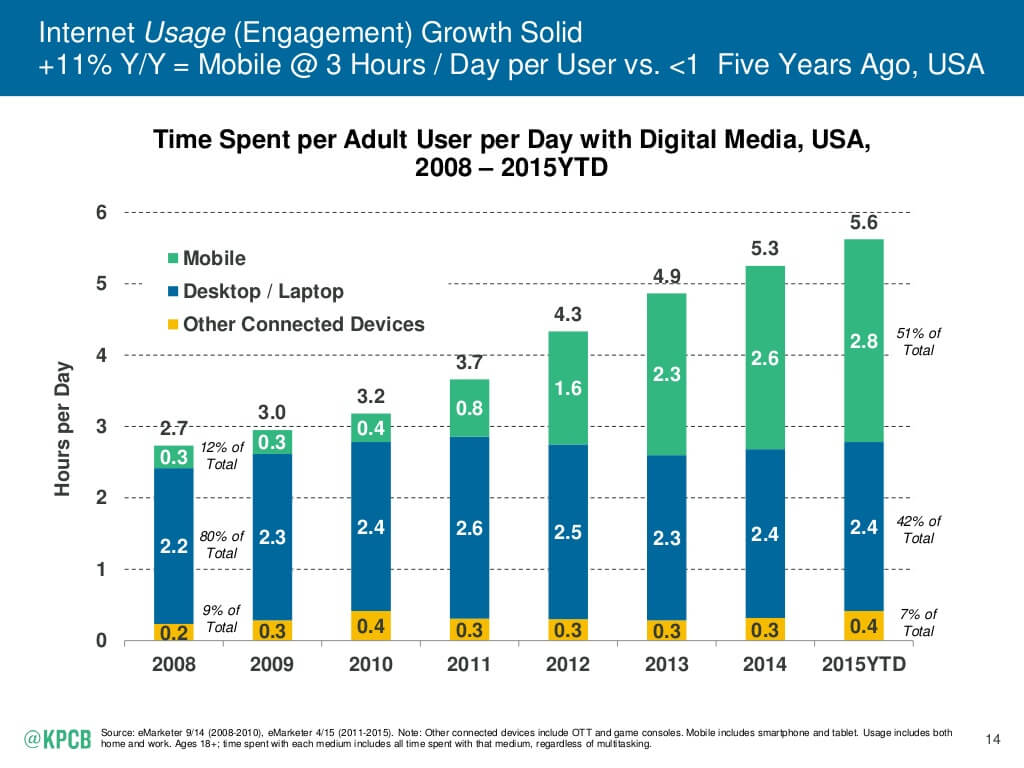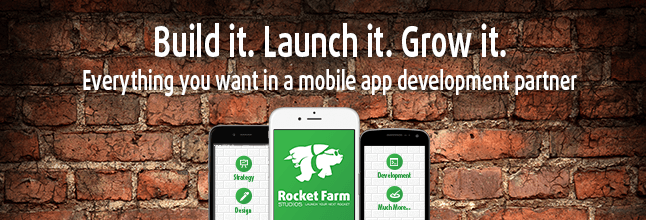“Mobile-first” isn’t just some Millennial buzzword. From small business to enterprise-level, it’s a reality of the market today. But for many, it’s happening so fast that it might be hard to understand what a mobile-first business strategy actually is. It’s pretty simple, actually. Here are the 3 keys to understanding what it means to be “mobile-first.”
1. Mobile-first is about your customers.
Last year’s global internet trends report by KPCB showed that from 2013 on, people have spent more time on mobile devices than on traditional computers. That was the turning point, just three years ago, that mobile-first became a reality and a necessity.

And you can bet that the mobile economy has been booming ever since. Remember, 59% of digital shopping occurs on mobile devices.
What this means is that customer are already deep in the mobile sea, and yet you might still be casting your net in the desktop pond that’s quickly drying up. A mobile-first strategy is simply getting front and center of today’s customers. It’s a simple goal, but companies need to truly internalize what that means.
Decades of a desktop-computer-first mentality can be hard to change, and we see it all the time when businesses try to design their own apps. Often they are so married to the desktop version and UX, that their mobile apps aren’t given a chance to break free to be something truly modern and different. And that’s not what the customers want.
2. Mobile-first is about your employees.
Mobile-first isn’t just outward facing, to your customers. It’s also an internal philosophy that will fundamentally improve your business’ efficiency. Remember the real reason that businesses love tablets? Ease of use. And that goes double for smartphones. Your employees already use mobile all day, all night, probably even when they should really be working. Because they’re people too. So the next simple key to a mobile-first strategy for your business is to utilize the mobile skills your employees already have.

This means developing mobile apps for your employees that don’t just extend their desktop user interface, but rather create new capabilities to make work more intuitively. Here’s a good piece on how mobile-first can improve the supply chain process. It mentions that since everyone has a phone with a HQ camera, it makes sharing images of problems easy and immediate. Is that something you can build into your company’s internal app?
The app we build for our client Leaderclips is a great example of this philosophy. Because they knew that their employees, like everyone else, are used to watching video clips on their phones, proprietary training videos were integrated directly into the app. By truly “mobilizing” your workforce, great strides can be made in your productivity. Take note of how your employees are already using their mobile devices in their day-to-day and consider adding these elements to company apps.
3. Mobile-first isn’t shrinking down. It’s a re-imagining.
Now that we know how “mobile-first” affects your business internally and externally, there’s one key to implementing the strategy: stop thinking small. As mentioned earlier, companies get into trouble when they try to replicate their old shopping site as a mobile app. But more than that, companies paint themselves into a corner by trying to fit their old methodology into a handheld device. From the backend architecture to the UI, build from the ground up with mobile in mind.
For example, with a drastically smaller screen, you simply can’t display everything you can on a desktop. This forces you to choose what is most important, and it’s a great exercise to undergo. Not only does it make you think through what needs to be seen first, but will also show you what doesn’t need to be there at all, especially since mobile users spend less time on screen. A post on nngroup.com highlighted this principle as “designing for interruptions:”
[Designing for interruptions] also means prioritizing the essential and simplifying tasks and interactions. Because attention is fragmented, strive to show users what they need as soon as possible. Flooding them with details and asking them to parse walls of text for relevant facts is not interruption friendly. The gist should always come before the minutiae. A simple task is easier to finish quickly. It’s also easier to resume than one with many steps and alternatives.
Mobile-first doesn’t mean shrink-down what you already have. It means re-imagine how it could be. If desktop is prose, mobile is haiku. You have to simplify, whittle down, and get agile. Because if you don’t, you’re still putting the past before mobile.
What do you think helps in your mobile-first strategy? Comment below!








